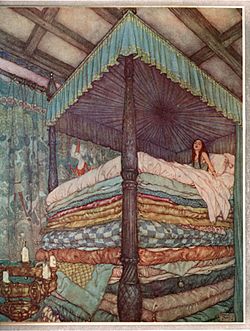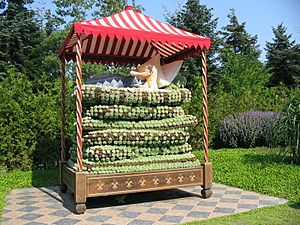The Princess and the Pea facts for kids
Quick facts for kids "The Princess and the Pea" |
|
|---|---|

1911 Illustration by Edmund Dulac
|
|
| Author | Hans Christian Andersen |
| Original title | "Prinsessen paa Ærten" |
| Translator | Charles Boner |
| Country | Denmark |
| Language | Danish |
| Genre(s) | Literary fairy tale |
| Published in | Tales, Told for Children. First Collection. First Booklet. 1835. |
| Publication type | Fairy tale collection |
| Publisher | C.A. Reitzel |
| Media type | |
| Publication date | 8 May 1835 |
| Published in English | 1846 in A Danish Story-Book |
"The Princess and the Pea" is a famous fairy tale written by Hans Christian Andersen. It tells the story of a prince who wants to marry a real princess. The tale was first published in Denmark on May 8, 1835. It was part of a small book of stories by Andersen.
This story is known worldwide and is listed as ATU 704, "The Princess and the Pea," in a special index that classifies folk tales.
Contents
Story Plot: How a Princess Was Tested
The story begins with a prince who really wants to find a true princess to marry. He travels all over the world, meeting many princesses. But he can never be sure if they are real princesses.
One very stormy night, a young woman arrives at the prince's castle. She is completely soaked from the rain. She says she is a princess, but the queen has some doubts.
The queen decides to test their unexpected guest. She places a tiny pea on the bed the princess will sleep in. Then, she covers the pea with twenty soft mattresses. On top of those, she adds twenty eider-down beds.
In the morning, the princess tells everyone she had a terrible night. She says something hard in the bed kept her awake and even bruised her. The prince's family then realizes she must be a real princess. Only a truly delicate princess could feel such a small pea through so many layers!
The prince and the princess get married and live happily. The story ends with the pea being put in a museum, where it might still be today.
Why This Fairy Tale Is Special
"The Princess and the Pea" has been enjoyed by many people. Some experts say that the story shows how people can prove their good qualities, just like the princess.
Even though it's an old story, it still feels real to many readers. This is because it talks about everyday feelings like love and hope. One expert, Paul Hazard, believed that Andersen's stories show real-life experiences, including challenges.
Another scholar, Niels Kofoed, noted that Andersen's tales appeal to everyone. They deal with common themes like love, nature, and even unfairness. Celia Catlett Anderson also pointed out that the story is appealing because it shows optimism winning over sadness. This can give readers hope for their own lives.
How the Story Has Been Adapted
"The Princess and the Pea" has inspired many other creative works:
- In 1927, a German composer named Ernst Toch created an opera based on the story.
- In 1959, it became a musical comedy called Once Upon a Mattress. The famous comedian Carol Burnett played the princess. This musical was brought back to the stage in 1997 with Sarah Jessica Parker.
- In 1984, Liza Minnelli starred in a TV version for Faerie Tale Theatre.
- The story has also been made into three films: a short IMAX movie in 2001, a full-length animated film in 2002, and another movie in 2005.
- It was even featured in a funny book called The Stinky Cheese Man and Other Fairly Stupid Tales. In this version, the prince tries a bowling ball instead of a pea!
- A poet named Jane Shore wrote a poem about the princess and the pea in 1973.
- In 2019, Simon Hood published a modern version of the story with animated pictures.
Similar Tales and Different Versions
There are other folk tales that are a bit like "The Princess and the Pea." In some stories, a boy finds a special pea or bean. He tries to guard it while sleeping on a bed of straw. People notice he is restless and think he must be from a royal family because he's not used to sleeping on straw.
Most versions of the story use only one pea. However, in some older translations, like one by Charles Boner, more than one pea was mentioned. The number of mattresses and feather beds can also change in different versions of the story.
Sometimes, there is a "helper" character who tells the princess to pretend she slept badly. In other versions, the princess decides to lie about her sleep all by herself.
See also
 In Spanish: La princesa y el guisante para niños
In Spanish: La princesa y el guisante para niños


